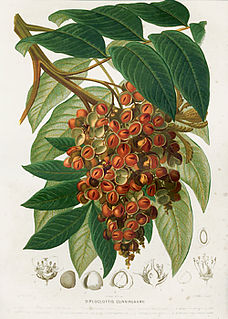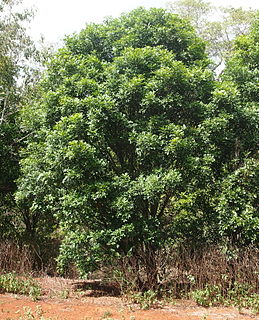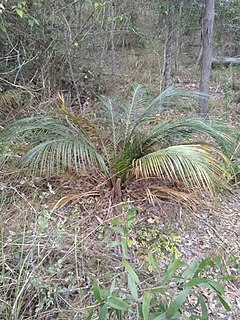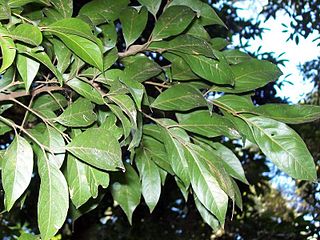Related Research Articles

Cupaniopsis is a genus of about 67 species of trees and shrubs of the soapberry family, Sapindaceae. They grow naturally in New Guinea, New Caledonia, Australia, Torres Strait Islands, Fiji, Samoa, Sulawesi, Micronesia. Many species have been threatened with extinction globally or nationally, with official recognition by the International Union for Conservation of Nature (IUCN) and several national and state governments.

Harpullia is a genus of about 27 species of small to medium-sized rainforest trees from the family Sapindaceae. They have a wide distribution ranging from India eastwards through Malesia, Papuasia and Australasia to the Pacific Islands. They grow naturally usually in or on the margins of rainforests or associated vegetation.
Jagera is a genus of 4 species of forest trees known to science, constituting part of the plant family Sapindaceae.

Diploglottis is a genus of 10 species of trees known to science, constituting part of the plant family Sapindaceae. They grow naturally in rainforests and margins of adjoining humid forests in eastern Australia and New Guinea. Some species are known as native tamarind or small-leaved tamarind; they have no direct relationship with the true tamarind.

Atalaya is a genus of eighteen species of trees and shrubs of the plant family Sapindaceae. As of 2013 fourteen species grow naturally in Australia and in neighbouring New Guinea only one endemic species is known to science. Three species are known growing naturally in southern Africa, including two species endemic to South Africa and one species in South Africa, Eswatini and Mozambique.

Lepiderema is a genus of nine species of trees from the family Sapindaceae. As of November 2013 botanists know of seven species growing naturally in Australia and two species in New Guinea. Published botanical science provides a limited knowledge of the full range of diversity in Australia and especially in New Guinea. In New Guinea the two known species have descriptions based each on only a single type specimen collection. Therefore, collection of more specimens and more species is most likely in New Guinea. In Australia they grow in rainforests of the northern half of the east coast side of the Great Dividing Range, from northeastern New South Wales through to northeastern Queensland.

Mischocarpus is a genus of about nineteen species of trees known to science, constituting part of the plant family Sapindaceae. They grow naturally from Australia and New Guinea, though Malesia as far north as the Philippines, through SE. Asia, Indo-China and S. China, to India at their farthest west. The eleven Australian species known to science grow naturally in the rainforests of the eastern coastal zone of New South Wales and Queensland, from Newcastle northwards through to north-eastern Queensland and Cape York Peninsula.

Macrozamia mountperriensis is a species of plant in the family Zamiaceae endemic to the area around Mount Perry in Queensland; however, it is not considered threatened due to its large population in the area. The species was discovered by colonial botanists including Frederick Manson Bailey and James Keys in the late 1800s. All members of the Zamiaceae family are considered to be poisonous.
Anthony Russell Bean is an Australian botanist who works at the Queensland Herbarium and Brisbane Botanic Gardens, Mount Coot-tha. Since 1982, he has led the Eucalyptus Study Group of the Society for Growing Australian Plants.

Sarcopteryx is a genus of about 12 rainforest tree species known to science, of the plant family Sapindaceae. They occur in Australia, New Guinea and the Moluccas.

Mischarytera is a genus of rainforest trees, constituting part of the plant family Sapindaceae. Four species are known to science as of December 2013, found growing naturally in eastern Queensland, Australia, and in New Guinea. Formerly until 1995, they had names within the genus Arytera, subgenus Mischarytera.
Rhysotoechia is a genus of tropical rainforest trees, constituting part of the plant family Sapindaceae.
Synima is a genus of tropical rainforest trees, constituting part of the plant family Sapindaceae.

Toechima daemelianum, commonly known as cape tamarind, is an evergreen tree from north-east Queensland in Australia. It grows up to 13 metres high and a trunk which may be up to 20 cm wide.
Dictyoneura is a genus of two-to-three species of rainforest trees known to science, constituting part of the plant family Sapindaceae.

Cossinia is a genus of four species of rainforest trees, constituting part of the plant family Sapindaceae. The genus has a disjunct distribution, occurring in Mascarene Islands, Australia, New Caledonia and Fiji.
Cossinia australiana is a species of seasonal rainforest trees endemic to restricted areas of Queensland, Australia, and constituting part of the plant family Sapindaceae.
Paul Irwin Forster obtained his doctorate in 2004 with his thesis: The pursuit of plants : studies on the systematics, ecology and chemistry of the vascular flora of Australia and related regions, from the University of Queensland.

Dischidia ovata is a plant in the genus Dischidia native to New Guinea and North Queensland. Named scientifically for its ovate leaves, its common name refers to the leaf venation that resembles a watermelon, similarly to unrelated plants like Peperomia argyreia. The species is succulent and grows as an epiphytic or lithophytic vine in a variety of habitats.
Dansiea grandiflora is a species of rainforest tree that is endemic to Queensland, Australia. It is known to exist only within a limited zone of notophyll vine forest on Cape York Peninsula. It is listed as ‘Vulnerable’ under the Queensland Nature Conservation Act (1992).
References
- 1 2 "Reynolds, Sally T. (1932-)". The International Plant Name Index. Retrieved 20 March 2020.
- ↑ Forster, Paul I. (2006). "Synima reynoldsiae P.I.Forst. (Sapindaceae), a new species from the 'Wet Tropics' of north-east Queensland". Austrobaileya. 7 (2): 285–291. ISSN 0155-4131. JSTOR 41739033.
- ↑ IPNI. S.T.Reynolds.